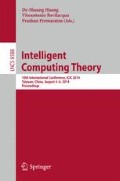Abstract
Premature birth is a significant worldwide problem. There is little understanding why premature births occur or the factors that contribute to its onset. However, it is generally agreed that early detection will help to mitigate the effects preterm birth has on the child and in some cases stop its onset. Research in mathematical modelling and information technology is beginning to produce some interesting results and is a line of enquiry that is likely to prove useful in the early prediction of premature births. This paper proposes a new approach which is based on a neural network architecture called Dynamic Self-organised Multilayer Network Inspired by the Immune Algorithm to analyse uterine electrohystography signals. The signals are pre-processed and features are extracted using the neural network and evaluated using the Mean Squared Error, Mean absolute error, and Normalized Mean Squared Error to rank their ability to discriminate between term and preterm records.
Access this chapter
Tax calculation will be finalised at checkout
Purchases are for personal use only
Preview
Unable to display preview. Download preview PDF.
References
Meng, Q., Zhou, W., Chen, Y., Zhou, J.: Feature analysis of epileptic EEG using nonlinear prediction method. In: Conf. Proc. IEEE Eng. Med. Biol. Soc., vol. 2010, pp. 3998–4001 (January 2010)
Sunde, C.: Noise Diagnostics of Stationary and Non-Stationary Reactor Processes. Chalmers University of Technology, Sweden (2007)
Rojas, R.: Neural Networks Introduction, A Systematic, 1st edn., p. 502. Springer (1996)
Fele-Zorz, G., Kavsek, G., Novak-Antolic, Z., Jager, F.: A comparison of various linear and non-linear signal processing techniques to separate uterine EMG records of term and pre-term delivery groups. Med. Biol. Eng. Comput. 46(9), 911–922 (2008)
Forney, E.M., Anderson, C.W.: Classification of EEG during imagined mental tasks by forecasting with Elman Recurrent Neural Networks. In: 2011 Int. Jt. Conf. Neural Networks, pp. 2749–2755 (July 2011)
Übeyli, E.D., Guler, I.: Statistics over Lyapunov Exponents for Feature Extraction: Electroencephalographic Changes Detection Case. World Acad. Sci. Eng. Technol., 625–628 (2007)
Guler, N., Ubeyli, E., Guler, I.: Recurrent neural networks employing Lyapunov exponents for EEG signals classification. Expert Syst. Appl. 29(3), 506–514 (2005)
Szkoła, J., Pancerz, K., Warchoł, J.: Recurrent neural networks in computer-based clinical decision support for laryngopathies: An experimental study. Comput. Intell. Neurosci. 2011, 289398 (2011)
Al-Jumeily, D., Hussain, A., Alaskar, H.: Recurrent Neural Networks Inspired by Artificial Immune Algorithm for Time Series Prediction. In: Proceedings of International Joint Conference on Neural Networks, Dallas, pp. 2047–2054 (2013)
Physionet.org, The Term-Preterm EHG Database (TPEHG DB) (2010), http://www.physionet.org/pn6/tpehgdb/
Baghamoradi, S., Naji, M., Aryadoost, H.: Evaluation of cepstral analysis of EHG signals to prediction of preterm labor. In: 18th Iranian Conference on Biomedical Engineering, pp. 1–3 (December 2011)
Diab, A., Hassan, M., Karlsson, B., Marque, C.: Effect of decimation on the classification rate of nonlinear analysis methods applied to uterine EMG signals. In: IRBM, pp. 12–14 (2013)
Bazregar, S., Mahdinejad, K.: Preterm Birth Detection Using EMG Signal Processing. Life Sci. J. 10(3), 25–30 (2013)
Moslem, B., Karlsson, B., Diab, M.O., Khalil, M., Marque, C.: Classification performance of the frequency-related parameters derived from uterine EMG signals. In: Conf. Proc. IEEE Eng. Med. Biol. Soc., vol. 2011, pp. 3371–3374 (January 2011)
Hassan, M., Terrien, J., Alexandersson, A., Marque, C., Karlsson, B.: Nonlinearity of EHG signals used to distinguish active labor from normal pregnancy contractions. In: 32nd Annual International Conference of the IEEE EMBS, pp. 2387–2390 (2010)
Diab, M.O., Moslem, B., Khalil, M., Marque, C.: Classification of uterine EMG signals by using Normalized Wavelet Packet Energy. In: 2012 16th IEEE Mediterr. Electrotech. Conf., pp. 335–338 (March 2012)
Widyanto, M.R., Nobuhara, H., Kawamoto, K., Hirota, K., Kusumoputro, B.: Improving recognition and generalization capability of back-propagation NN using self-organized network inspired by immune algorithm. Appl. Soft Comput. 6, 72–84 (2005)
Shen, X., Gao, X.Z., Bie, R.: Artificial Immune Networks:Model and Application. Int. J. Comput. Intell. Syst. 1, 168–176 (2008)
Jordan, M.I.: Attractor dynamics and parallelism in a connectionist sequential machine. In: Artificial Neural Networks, pp. 112–127. IEEE Press, Piscataway (1990)
Voegtlin, T.: Recursive self-organizing maps. Neural Netw. 15(8-9), 979–991 (2002)
Balli, T., Palaniappan, R.: Classification of biological signals using linear and nonlinear features. Physiol. Meas. 31(7), 903–920 (2010)
Author information
Authors and Affiliations
Editor information
Editors and Affiliations
Rights and permissions
Copyright information
© 2014 Springer International Publishing Switzerland
About this paper
Cite this paper
Alaskar, H., Hussain, A.J., Paul, F.H., Al-Jumeily, D., Tawfik, H., Hamdan, H. (2014). Feature Analysis of Uterine Electrohystography Signal Using Dynamic Self-organised Multilayer Network Inspired by the Immune Algorithm. In: Huang, DS., Bevilacqua, V., Premaratne, P. (eds) Intelligent Computing Theory. ICIC 2014. Lecture Notes in Computer Science, vol 8588. Springer, Cham. https://doi.org/10.1007/978-3-319-09333-8_22
Download citation
DOI: https://doi.org/10.1007/978-3-319-09333-8_22
Publisher Name: Springer, Cham
Print ISBN: 978-3-319-09332-1
Online ISBN: 978-3-319-09333-8
eBook Packages: Computer ScienceComputer Science (R0)

